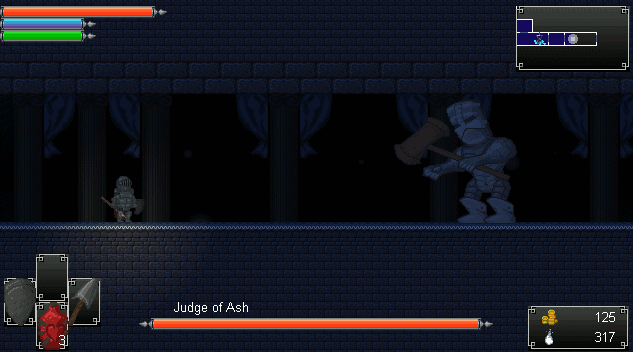Overview/Programs Used (so far):
- Aseprite
- GameMaker Studio 2
- Spine
I have a project I'm working on in GameMaker Studio 2 version 2.3.7.606. The project is a 2D adventure/RPG, and it is heavily pixelated (emphasis on pixel art). I'm wondering if there is a way to implement a dynamic equipment system from inventory-based input.
I.e, I would like my sprite/object to change depending on which piece of gear I've "equipped" from my inventory (4 slots of gear: head, chest, legs, boots [and weapons of course]). I want to implement this with various different pieces and amalgamations of armor, which means that there could be (for example) 10 different head variations, 10 chest variations, etc. that I would like to be drawn to the player sprite/object seamlessly and dynamically.
Example:
- Say I equip a helmet (right clicking it in my inventory), I want that helmet to then appear on my player, and stay on my player until I unequip (place it back into my inventory) it, which means the equipped item would persist through my run animation, jump animation, roll animation, etc.
So far, the best option I've seen (days of research) is using the program Spine, utilizing its GMS2 functionality, since Spine has an intuitive bone system that lets each piece of the sprite's appearance change dynamically based on a piece of equipment being equipped. That being said, Spine doesn't work well with pixelated animation, and even after investigating workarounds, I can't wrap my head around the endeavor of animating a pixelated sprite in this manner.
My proposed solution:
I would like to (somehow) export hand-drawn animations from Aseprite (our sprite art program [there is a script I use to import stuff to Spine from here already and it works*]) and import them into Spine while NOT utilizing Spine's animation features, which I know sounds weird, but that's the best way I could think to use it without heavily altering our current art-style.
The problem with my proposed solution:
- I have no idea how or IF there is any way to import hand-drawn animation strips/sequences from Aseprite to Spine.
- I'm currently using Spine Trial to test this, and I'm not sure if I will even be able to do this type of thing (IF it exists) with Spine Essential (the only version I can remotely afford).
Conclusion: This is a major roadblock in my project, and it has the possibility to make or break my project's RPG-feel. I have looked all over the internet for any type of answer for this, to no avail. Please let me know if this is possible, or if there are any alternatives (I wouldn't be typing this, however, if I hadn't tried everything I could think of).
Thanks,
Bobink
- Aseprite
- GameMaker Studio 2
- Spine
I have a project I'm working on in GameMaker Studio 2 version 2.3.7.606. The project is a 2D adventure/RPG, and it is heavily pixelated (emphasis on pixel art). I'm wondering if there is a way to implement a dynamic equipment system from inventory-based input.
I.e, I would like my sprite/object to change depending on which piece of gear I've "equipped" from my inventory (4 slots of gear: head, chest, legs, boots [and weapons of course]). I want to implement this with various different pieces and amalgamations of armor, which means that there could be (for example) 10 different head variations, 10 chest variations, etc. that I would like to be drawn to the player sprite/object seamlessly and dynamically.
Example:
- Say I equip a helmet (right clicking it in my inventory), I want that helmet to then appear on my player, and stay on my player until I unequip (place it back into my inventory) it, which means the equipped item would persist through my run animation, jump animation, roll animation, etc.
So far, the best option I've seen (days of research) is using the program Spine, utilizing its GMS2 functionality, since Spine has an intuitive bone system that lets each piece of the sprite's appearance change dynamically based on a piece of equipment being equipped. That being said, Spine doesn't work well with pixelated animation, and even after investigating workarounds, I can't wrap my head around the endeavor of animating a pixelated sprite in this manner.
My proposed solution:
I would like to (somehow) export hand-drawn animations from Aseprite (our sprite art program [there is a script I use to import stuff to Spine from here already and it works*]) and import them into Spine while NOT utilizing Spine's animation features, which I know sounds weird, but that's the best way I could think to use it without heavily altering our current art-style.
The problem with my proposed solution:
- I have no idea how or IF there is any way to import hand-drawn animation strips/sequences from Aseprite to Spine.
- I'm currently using Spine Trial to test this, and I'm not sure if I will even be able to do this type of thing (IF it exists) with Spine Essential (the only version I can remotely afford).
Conclusion: This is a major roadblock in my project, and it has the possibility to make or break my project's RPG-feel. I have looked all over the internet for any type of answer for this, to no avail. Please let me know if this is possible, or if there are any alternatives (I wouldn't be typing this, however, if I hadn't tried everything I could think of).
Thanks,
Bobink











